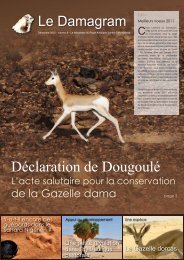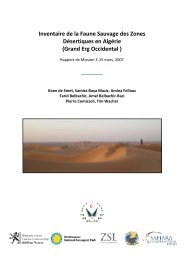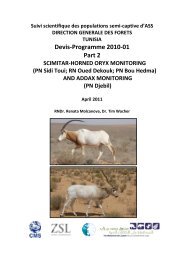The Biology, Husbandry and Conservation Scimitar-horned Oryx ...
The Biology, Husbandry and Conservation Scimitar-horned Oryx ...
The Biology, Husbandry and Conservation Scimitar-horned Oryx ...
You also want an ePaper? Increase the reach of your titles
YUMPU automatically turns print PDFs into web optimized ePapers that Google loves.
7<br />
<strong>Conservation</strong><br />
14<br />
Part 1: <strong>Biology</strong> & <strong>Conservation</strong><br />
SIMON WAKEFIELD, JUERGEN ENGEL & TANIA GILBERT<br />
Former & Current Distribution of <strong>Scimitar</strong>-<strong>horned</strong> <strong>Oryx</strong> in North Africa<br />
Red Data Book listing: Extinct in the Wild (IUCN, 2002).<br />
In former times scimitar-<strong>horned</strong> oryx were common in large areas of northern Africa (figure 1). <strong>The</strong><br />
species’ range extended from the Atlantic Ocean almost up to the Red Sea <strong>and</strong> from the<br />
Mediterranean Sea to the 15 th degree of northern latitude (Haltenorth, 1963; Schomber, 1963;<br />
Wilson, 1980). Only the eastern boundary of their former distribution is a subject of controversy.<br />
Some authors (e.g. Bonnet, 1909; Brehm, 1920; Flower, 1932; Harper, 1945; Dolan, 1966; Kock,<br />
1970; Newby, 1988) state that the river Nile represented the limit of the species range, however<br />
others (Haltenorth, 1963; Schomber, 1963; Gillet, 1965, 1966a; Mungall & Sheffield, 1994), believe<br />
that the oryx occupied additional areas east of the river.<br />
Being a sub- or semi-desert species, the actual distribution would have been dictated by available<br />
habitat, <strong>and</strong> therefore the described range was never uniformly occupied (Newby, 1978, 1988).<br />
Typically, the perennial grassl<strong>and</strong> formations, dry acacia woodl<strong>and</strong>s <strong>and</strong> flushes of annual herbs<br />
<strong>and</strong> grasses, which the oryx utilise, occur where annual precipitation is between 75 <strong>and</strong> 400mm.<br />
During the arid conditions of the last three thous<strong>and</strong> years, this has meant that the potential<br />
distribution has been largely the northern <strong>and</strong> southern sub-desert fringes of the Sahara, <strong>and</strong><br />
potentially in areas such as the fringes of central Saharan mountains where local run-off supports<br />
these vegetation communities (Devillers & Devillers-Terschuren, 2003).<br />
<strong>The</strong> range of the scimitar-<strong>horned</strong> oryx is thought to have declined since Roman times, due to<br />
habitat loss <strong>and</strong> hunting (Newby, 1988; Gordon, 1991). All the populations on the northern fringe<br />
of the Sahara had certainly disappeared by the beginning of the 20th century. <strong>The</strong> southern<br />
Sahelian range remained almost continuous until the 1960’s, became fragmented into several<br />
larger portions during the 1970’s, persisted as two fragments in Niger <strong>and</strong> Chad during the 1980’s,<br />
until finally the species was only thought to occur in Chad (Newby, 1988).<br />
In 1976, scimitar-<strong>horned</strong> oryx were classified as vulnerable by IUCN. By then resident<br />
populations had already disappeared from Algeria, Burkino Faso, Egypt, Libya, Mauritania,<br />
Morocco, Senegal, Tunisia, <strong>and</strong> Western Sahara, leaving only four countries (Chad, Mali, Niger<br />
<strong>and</strong> Sudan) with extant populations. Soon afterwards the oryx in Sudan, which had already been<br />
reduced to a few isolated herds in the Darfur region, become extinct (Newby, 1982). <strong>The</strong> formerly<br />
widespread population of Mali is believed to have become extinct in 1981 (Lamarche – in Newby,<br />
1988), <strong>and</strong> by this time the population of Niger was reduced to probably less than 200. <strong>The</strong> last<br />
oryx seen in Niger was a herd of four animals located between the Aϊr mountains <strong>and</strong> Termit in<br />
1983, <strong>and</strong> scimitar-<strong>horned</strong> oryx are believed to have become extinct in Niger that year (Newby,<br />
1988).





